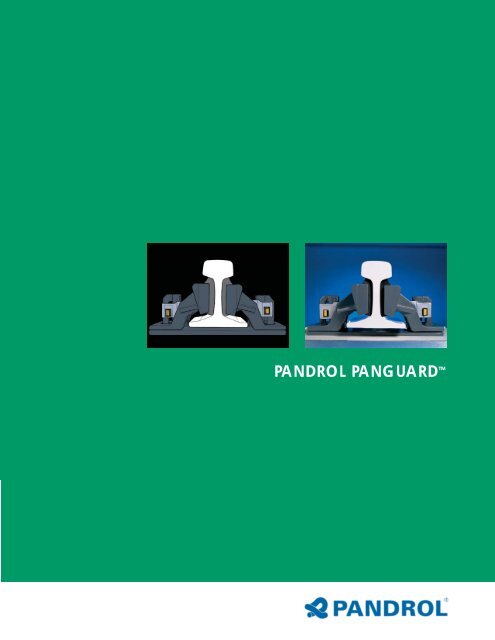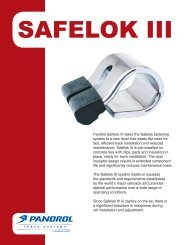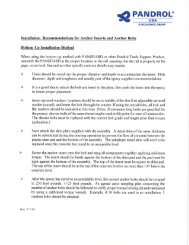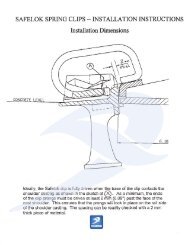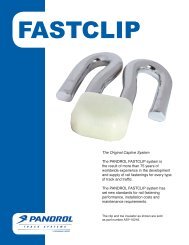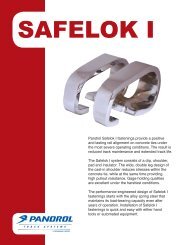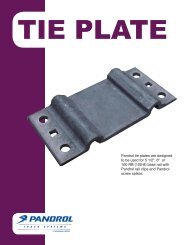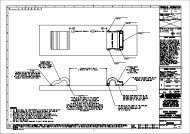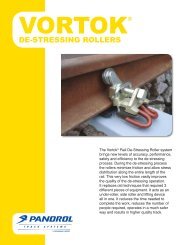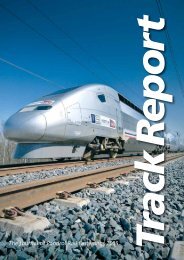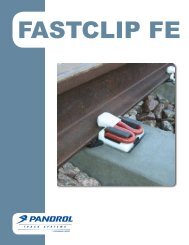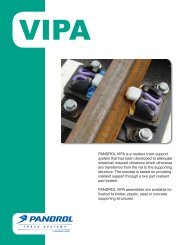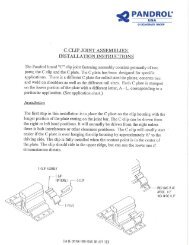PANDROL PANGUARD™ - Pandrol USA
PANDROL PANGUARD™ - Pandrol USA
PANDROL PANGUARD™ - Pandrol USA
You also want an ePaper? Increase the reach of your titles
YUMPU automatically turns print PDFs into web optimized ePapers that Google loves.
<strong>PANDROL</strong> PANGUARD
PANGUARD <br />
In vibration and noise sensitive areas, most track designs in use around the world work on one of two principles<br />
to reduce groundborne vibration – either by increasing the mass of the resiliently supported track structure or<br />
by reducing the stiffness of the support. The lower the track stiffness which can be achieved, the lower the<br />
resonant frequency becomes, and the better the vibration attenuation which results. But before the<br />
<strong>Pandrol</strong> PANGUARD system, large vertical deflections also resulted in unacceptable lateral movement of<br />
the rail head.<br />
The <strong>Pandrol</strong> PANGUARD system delivers an assembly with both very low vertical stiffness and minimal rail roll<br />
and delivers exceptional vibration reduction performance at a much lower cost than floating slab.<br />
In the <strong>Pandrol</strong> PANGUARD assembly, the rail is supported under the head and in the web with large rubber wedges, leaving the<br />
foot of the rail suspended. The rubber wedges are held in place by cast-iron side brackets which are in turn fastened either to a<br />
shoulder cast into a concrete tie or block, or to a baseplate fixed to the track base using either bolts or screwspikes. The<br />
baseplate system can be used on slab track, wood ties or on steel or concrete bridges.<br />
The assembly allows large vertical deflections, and although it is resilient in a lateral direction, rail roll is minimised because the<br />
forces applied to the rail head are reacted much closer to their line of application than in a conventional fastening.<br />
Key components<br />
Cast in Shoulder Assembly<br />
Side support bracket<br />
Rubber wedge<br />
Cast iron<br />
locking<br />
wedge<br />
Typical key dimensions<br />
Inclination of the rail is provided in the concrete tie or<br />
slab into which the assembly is set.<br />
Height of rail base above concrete level: 5/8" (17mm)<br />
Length of rubber rail supports: 9 7/8" (250mm)<br />
Width of assembly along rail axis: 5 7/8" (150mm)<br />
Width of assembly perpendicular to rail axis: 13"<br />
(330mm)<br />
Shoulder
Key components<br />
Baseplate Assembly<br />
Rubber wedge<br />
Side support bracket<br />
Serrated Adjustment<br />
Washer<br />
Cast iron<br />
locking<br />
wedge<br />
Typical key dimensions<br />
Inclination of the rail is provided in the baseplate.<br />
Height of rail base above tie: 1 3/16" (30mm)<br />
Length of rubber rail supports: 9 7/8" (250mm)<br />
Width of assembly along rail axis: 7 7/8" (200mm)<br />
Width of assembly perpendicular to rail axis: 19 1/4"<br />
(490mm)<br />
Baseplate<br />
Hook In<br />
Shoulder<br />
Advantages<br />
•Very low dynamic stiffness – 4.28 X104 lb/in (7.5kN/mm) or less leads to:<br />
✓ minimal rail roll<br />
✓ a low vibration performance similar to floating slab track but<br />
- at a much lower cost and<br />
- with much better access for maintenance or adjustment<br />
•Reduces vibration and secondary noise significantly<br />
•Very low profile:<br />
✓ can fit within existing restricted rail heights to:<br />
- provide a retrofit solution in areas where space or cost prohibits the use of floating slab track<br />
- reduce tunnel diameters and costs for new track construction, giving very large savings in project costs.<br />
•All components are easily replaced for ease of maintenance<br />
•Low longitudinal stiffness avoids load transfer between rail and bridge on thermal expansion<br />
•Longitudinal creep resistance can be adjusted in situ to suit requirement<br />
•Uses proven materials technology
PANGUARD <br />
Application and Installation<br />
The <strong>Pandrol</strong> PANGUARD system is available in two different versions – as a baseplate assembly, or as a<br />
cast-in assembly. Both offer the same low stiffness and consequent high vibration attenuation capability.<br />
The choice as to which to use depends mainly on the preferred method of installation. The cast-in version<br />
on ties or individual rail seat blocks is particularly suitable for top down construction and for retrofit in<br />
place of existing ties or blocks. The baseplate assembly has been designed in order that it can be easily<br />
slid into place under the rail as a retrofit in place of existing less resilient rail fasteners. As with other<br />
baseplates, it can also be used for new construction with either the top down or bottom up method.<br />
Cast-in Assembly<br />
Baseplate Assembly<br />
Installation Tools<br />
The <strong>Pandrol</strong> PANGUARD system fastens the rail at the web unlike<br />
conventional fasteners that clamp the rail base. Therefore slightly<br />
different techniques are used to install this assembly. However, all<br />
conventional forms of track construction can be applied when<br />
fitting PANGUARD and there is no need for expensive or<br />
complicated equipment. The principle of installation is to apply a<br />
lateral precompression to the rubber supporting blocks. This force<br />
maintains the rail position laterally while allowing it to deflect in the<br />
vertical plane. Installation is a one man operation using a simple<br />
hand tool to apply the clamping force.
<strong>Pandrol</strong> PANGUARD is suitable for application on concrete ties, wood ties, slab track and bridges. The assembly features height<br />
adjustment within the assembly itself, or by shimming under a baseplate. Lateral adjustment is also available, either within the<br />
assembly or via the baseplate.<br />
Bridge Application on Concrete Ties in Ballast<br />
Tunnel Application on Concrete Slab<br />
Baseplate Application on Concrete Slab<br />
Laboratory Testing<br />
Before its first installation in track, the <strong>Pandrol</strong> PANGUARD<br />
system was tested extensively in the laboratory. A range<br />
of tests and measurements were made, as follows:<br />
• Repeated inclined dynamic load test, run for more<br />
than 4.5 million cycles<br />
• Dynamic stiffness of the assembly<br />
• Longitudinal stiffness and creep properties<br />
• Electrical resistance<br />
• Accelerated ageing (corrosion)<br />
• Resistance to chemicals used on the track<br />
• Fire resistance<br />
Laboratory Test Reports are available on request.<br />
Inclined Dynamic Stiffness Test Arrangement
PANGUARD <br />
Suitable Applications<br />
Applications of <strong>Pandrol</strong> PANGUARD make use of the product’s unique characteristics. Its low overall<br />
height makes it very suitable where lower stiffness is required in existing track, but the rail head level<br />
cannot be raised. The very high level of vibration attenuation achieved with the system can be used to<br />
control ground vibration – for instance from trains running in tunnels, or to reduce the noise emitted from<br />
vibration of structures such as bridges or viaducts. Examples of two applications are given below – one<br />
in which a primary objective was control of ground vibration and the other in which it was used to<br />
investigate the system’s capacity to reduce noise from a bridge.<br />
Case Study 1<br />
London Underground, UK<br />
Installation of <strong>Pandrol</strong> PANGUARD on concrete ties in place of wooden ties with baseplates.<br />
The installation was intended to reduce groundborne vibration from tunnels.<br />
Rail Spacing Axle Load<br />
BS113A 0,9m 11 tons<br />
Invert Vertical Vibration<br />
90<br />
87.3<br />
Vibration velocity dB (ref. 5E-8m/s)<br />
80<br />
70<br />
60<br />
50<br />
40<br />
Before<br />
After<br />
69.7<br />
Insertion Loss – 17.6 dB<br />
Note - Bars show total<br />
vibration levels<br />
30<br />
50 100 200 500 1000 2000<br />
Frequency (Hz)
Case Study 2<br />
Railtrack, UK<br />
Installation of <strong>Pandrol</strong> PANGUARD on concrete ties on a ballasted steel bridge structure.<br />
The installation was aimed at the reduction of secondary noise resulting from vibration of a steel bridge under rail traffic.<br />
Rail Spacing Axle Load<br />
BS113A 0,65m 28 tons<br />
90<br />
Noise under bridge (4m below bridge)<br />
Sound Pressure Lmax dB(A) (ref 20E-6Pa)<br />
80<br />
70<br />
60<br />
Insertion Loss – 6.7 dB(A) 50<br />
Note – Bars show total<br />
sound pressure levels<br />
50<br />
63<br />
80<br />
Before<br />
After<br />
100<br />
125<br />
160<br />
200<br />
250<br />
315<br />
400<br />
Frequency (Hz)<br />
500<br />
630<br />
800<br />
1000<br />
1250<br />
1600<br />
2000<br />
2500<br />
3150<br />
4000<br />
5000<br />
83.4<br />
76.7<br />
Total<br />
dB(A)
<strong>Pandrol</strong> <strong>USA</strong>, LP<br />
501 Sharptown Road, P.O. Box 367<br />
Bridgeport, NJ 08014<br />
Phone (856) 467-3227 or (800) 221-CLIP<br />
Fax (856) 467-2994<br />
Website www.pandrolusa.com<br />
<strong>Pandrol</strong> Canada Limited<br />
6910 34th Street<br />
Edmonton, Alberta T6B 2X2, Canada<br />
Phone 780-413-4281<br />
Fax 780-413-4283<br />
‘PANGUARD’ is a registered trademark of <strong>Pandrol</strong> <strong>USA</strong>, LP<br />
The technical information given in this brochure was correct at the time of printing, but the company undertakes a continuing program of<br />
research and development and improvements may have since been introduced.<br />
2005


